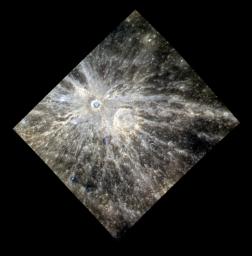
|
The Bright Rays of Xiao Zhao
- Click the image above for a larger view
- Full-Res JPEG (1513 x 1539) (222.3 kB)
- Full-Res TIFF (1513 x 1539) (7.0 MB)
Caption:
The bright rays of Xiao Zhao dominate this scene. These rays indicate that Xiao Zhao is a relatively young crater. Eastman crater can be seen to the southwest of Xiao Zhao. The eight different color filters of the WAC that are used to create the color base map have central wavelengths of 430, 480, 560, 630, 750, 830, 900, and 1000 nm. The images acquired through these narrow-band filters are combined to create color images that accentuate color differences on Mercury's surface. As an example, this image was created by using three images acquired as part of the color base map with the central wavelengths of 1000, 750, and 430 nm displayed in red, green, and blue, respectively. This particular combination allows the visualization of details, some of which would be invisible to the human eye.
This image was acquired as a high-resolution targeted observation. Targeted observations are images of a small area on Mercury's surface at resolutions much higher than the 250-meter/pixel (820 feet/pixel) morphology base map or the 1-kilometer/pixel (0.6 miles/pixel) color base map. It is not possible to cover all of Mercury's surface at this high resolution during MESSENGER's one-year mission, but several areas of high scientific interest are generally imaged in this mode each week.
Date acquired:
December 29, 2011
Image Mission Elapsed Time (MET):
233687507, 233687511, 233687527
Image ID:
1199649, 1199650, 1199654
Instrument:
Wide Angle Camera (WAC) of the Mercury Dual Imaging System (MDIS)
WAC filter:
9 (1000 nanometers), 7 (750 nanometers), 6 (433 nanometers) as red-green-blue
Center Latitude:
9.6°
Center Longitude:
125.8° E
Resolution:
443 meters/pixel
Scale:
The rayed crater Xiao Zhao is 24 km (15 mi.) in diameter.
Incidence Angle:
26.9°
Emission Angle:
14.1°
Phase Angle:
28.0°
Background Info:
The MESSENGER spacecraft is the first ever to orbit the planet Mercury, and the spacecraft's seven scientific instruments and radio science investigation are unraveling the history and evolution of the Solar System's innermost planet. Visit the Why Mercury? section of this website to learn more about the key science questions that the MESSENGER mission is addressing. During the one-year primary mission, MDIS is scheduled to acquire more than 75,000 images in support of MESSENGER's science goals.
These images are from MESSENGER, a NASA Discovery mission to conduct the first orbital study of the innermost planet, Mercury. For information regarding the use of images, see the MESSENGER image use policy .
Cataloging Keywords:
| Name | Value | Additional Values |
|---|---|---|
| Target | Mercury | |
| System | ||
| Target Type | Planet | |
| Mission | MESSENGER | |
| Instrument Host | MESSENGER | |
| Host Type | Orbiter | |
| Instrument | Mercury Dual Imaging System (MDIS) | |
| Detector | Wide Angle Camera (WAC) | |
| Extra Keywords | Color, Crater, Map, Radio | |
| Acquisition Date | ||
| Release Date | 2012-02-07 | |
| Date in Caption | 2011-12-29 | |
| Image Credit | NASA/Johns Hopkins University Applied Physics Laboratory/Carnegie Institution of Washington | |
| Source | photojournal.jpl.nasa.gov/catalog/PIA15371 | |
| Identifier | PIA15371 | |
